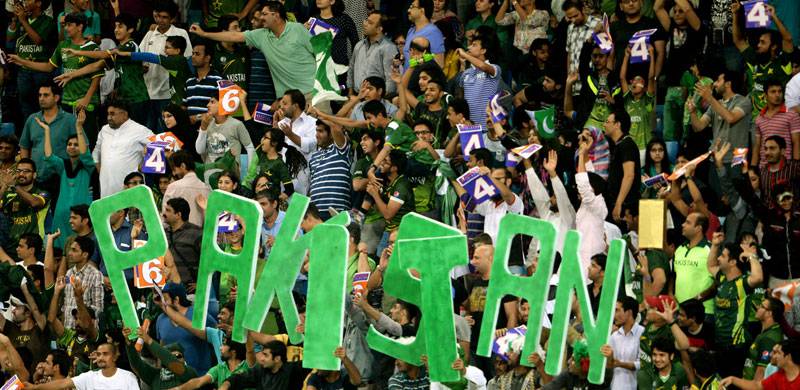
Right from the moment of its sudden inception in August 1947, Pakistan began to suffer a series of socio-political fissures. The country constituted various distinct ethnicities, religions, Islamic sects and sub-sects. Instead of harmonizing the cultural, ethnic and sectarian differences through a democratic mechanism, the state tried to push them aside with the help of a monolithic ideology that was almost entirely constructed by the state as opposed to it being framed through a democratically achieved consensus.
Today, Pakistan’s status as a country with extensive religious, ethnic and sectarian tensions is a continuation of a process triggered by the early blunders committed by the state, the governments, religious leaders and ideologues. These elements treated Pakistan as a lab[1] where political and religious experiments could be conducted without much concern for its diverse polity. They were almost entirely unable to predict the kind of long-term impacts that their tinkering and excursions into the territory of social and political engineering would eventually have on the fate of the country.
The process has so far unfolded in three phases. The initial tensions in the society were based on class differences, till ethnicity eschewed the class factor and replaced ‘class war’ with political conflicts battled on the basis of ethnic identities. Ethnic tensions (when they began to exhaust themselves from the late 1980s onwards) were followed by fissures in the polity on sectarian and sub-sectarian grounds. All three fissures – class, ethnicity and sectarian – are not entirely exclusive. Beneath each are echoes of the other. They are part of a single evolutionary current.
One interesting way of understanding the trajectory of Pakistan’s ideological evolution in this context is by studying the country’s cricket culture. Cricket in South Asia is much more than just a game. In India and Pakistan (and to a certain extent, in Sri Lanka and Bangladesh as well) cricket is like what football is in most Latin American countries. Or, for that matter, what cricket once was on the cricket-playing Caribbean islands (the West Indies). It prominently reflects the socio-political mindset of a country’s polity and state. This also includes the game (or the team) reflecting (or being directly affected by) social, political and economic crevices present in a country. Every Test playing side in South Asia has exhibited this.
Simon Lister in his 2007 book Supercat quotes the most successful West Indian cricket captain, Clive Lloyd (who was made skipper in 1974) as saying that till the early 1970s, ‘West Indian players played to please white people’ and that ‘black cricketers were seen as something exotic, whose only role was to entertain white audiences.’
But in the 1970s, things were changing on the islands. Left-wing unrest, political turmoil and street violence had gripped the region. These were directly inspired by the emergence of radical ‘Black Power’ groups and civil rights movements in the United States in the 1960s.
Hilary Beckles in her detailed study of West Indian cricket wrote that the West Indian nations had begun to search for an identity that was not shaped by their bygone colonial overlords. The nations were also looking to assert a nationalism based on the black culture that had developed on the islands. Amidst riots, assassinations, collapsing economies and growing animosity between the islands, cricket became the sport which not only managed to instill a sense of racial unity between the islands, but the sport also became an expression of collective West Indian nationalism.
Between 1976 and 1989, every game by the West Indies was played as if it was an act of war and the players were psyched to believe that the existence of the West Indian nations banked on how the team performed on the field. By the early 1990s, the politics and economies of the island nations had greatly stabilized and improved. Ironically, this is when West Indian cricket began to decline. It was as if due to the political and economic improvements on the islands, West Indian cricket lost its purpose and meaning. The besieged mindset that had driven West Indian cricket between 1976 and late 1980s had withered away.
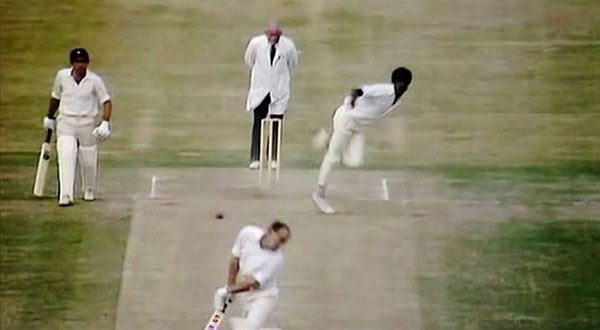
It begins: The West Indies fast bowlers terrorized England batsmen during the 1976 WI-England series in England. Incensed by the remarks of England skipper, Tony Grieg, which the WI captain, Clive Lloyd believed were ‘racist,’ WI struck back by winning the series 3-0. Many believe this series marked the beginnings of West Indian nationalism.
The vicious civil war between the Sinhalese-dominated state of Sri Lanka and the country’s Tamil minority (1980-2011) impacted the Sri Lankan cricket for decades. In his 1988 autobiography[2], former Pakistan cricket captain, Imran Khan, explained how during Pakistan’s 1987 tour of Sri Lanka, the Pakistan team had to continuously face hostile crowds and biased umpiring. Khan suggested that the Lankan state’s war against the militant guerilla outfit Tamil Tigers was going badly and society was facing unprecedented violence.
There was tension around the playing venues and the state was desperate for a Test victory to soften the blow of the raging civil war.
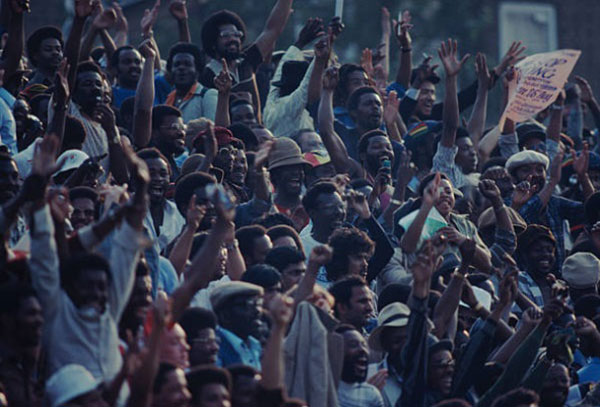
A boisterous WI crowd during the 1979 Cricket World Cup final. West Indian cricket sharply mirrored West Indian nationalism.
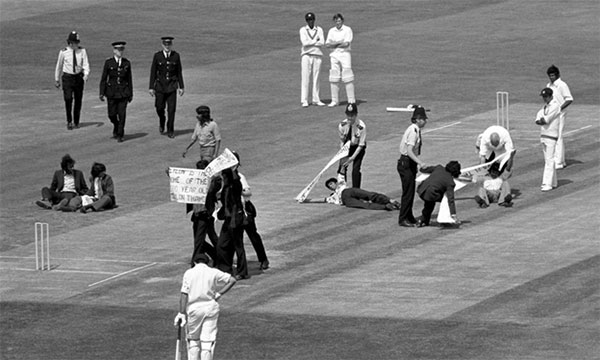
Tamil nationalists invade the field during a Sri Lanka-Australia game at the 1975 Cricket World Cup in England.
In India, when a widespread protest movement was developing against Prime Minister Indira Gandhi’s increasingly autocratic government in the 1970s, Indian politics went into a tailspin. There was widespread rioting, growing incidents of crime. Indian society stood precariously polarized. The tension crept in the Indian cricket team as well that was touring England in 1974.
Reports began to emerge about how members of the team were bickering among themselves and were not entirely focused on cricket.[3] India lost the series 3-0 and then, to cap it all, one of the team’s batsmen, Sudhir Naik, was accused and arrested for stealing some socks from a London store.[4] As Indira was contemplating to enforce tougher measures to curb the movement against her, the Indian cricket team saw itself being asked to leave a reception held by the Indian Ambassador to England.[5] The Ambassador was angry that the team turned up 40 minutes late. The embarrassed squad returned to its hotel.
The Indian captain, Ajit Wadekar, began to accuse some senior players of the squad of being government stooges and ‘Patuadi’s men.’[6] Till then MA Khan Pataudi had been one of Indian’s most successful captains, but was not with the team in England. In 1975, the year Indira imposed an emergency and assumed almost dictatorial powers, Wadekar was dropped and replaced by Pataudi as captain.
Recently, the overt emergence of Hindu nationalism in India and the militaristic aspect inherent in this nationalism was mirrored by the country’s cricket squad when it decided to wear military caps in an ODI against Australia. Examples of how a South Asian cricket team can so vividly reflect a country’s ups and downs, fissures and divides are plenty.
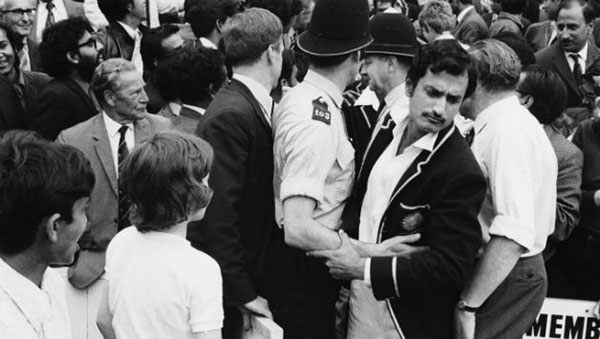
Indian skipper Ajit Wadekar was not a happy man during India’s 1974 series against England. India lost 3-0. The political polarization in India was mirrored by the Indian squads which split into factions. Wadekar also accused some of his players of being ‘Pataudi’s men.’
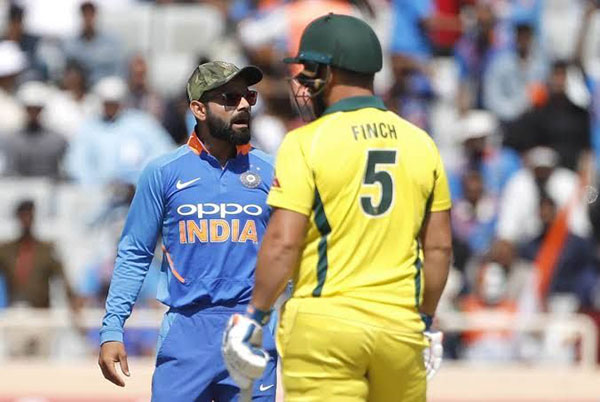
Indian captain Virat Kohli in an army cap squares up with Australian skipper Aaron Finch.
A class apart
Pakistan inherited very little by way of industry and infrastructure when it separated from the rest of India to become an independent country. One of the first tasks of its founder, Muhammad Ali Jinnah, was to encourage Muslim industrialists and bureaucrats to move (from India) to Pakistan and help the government construct the new country’s economic and state infrastructure.
The state was willing to give extraordinary help and leeway to these men. But a majority of Pakistanis were poor and many did not appreciate the state’s overt reliance on rich men. That’s why leftist organizations such as the Communist Party of Pakistan (CPP) and its student-wing, the Democratic Students Federation (DSF) managed to make early in-roads on the side of the peasants and the working classes in (what the communists believed) was an emerging class war in Pakistan.[7]
When Pakistan gained international Test cricket status in 1952, the country’s cricket board chose an Oxford-educated and well-to-do man to lead the country’s first Test side. Abdul Hafeez Kardar had a haughty and authoritarian personality. He was to lead a team, most of whose members were not only inexperienced, but they also came from economic backgrounds that were below Kardar’s. Most of the players could not even afford to buy their own playing kit and had to borrow things like bats, gloves, pads and even shoes from friends and others.[8]
Nevertheless, Kardar led the team well and under him Pakistan was able to win a string of Test matches. The team remained largely stable during Kardar’s captaincy (1952-58) but class tensions between the players were obvious. In his autobiography, Pakistan’s classic opening batsman, Hanif Muhammad, laments the fact that in spite of Kardar being an inspirational captain, he could not shed his aristocratic baggage and demeanor. Hanif claimed that Kardar destroyed the career of one of his (Hanif’s) brothers, Raees Mohammad.[9]
Hanif wrote that Raees was as talented as he was. However, according to Hanif, since his family did not come from a very educated and well-to-do background, Kardar continued to play Maqsood Ahmed in place of Raees. Maqsood came from an established middle-class family and was Kardar’s ‘drinking buddy.’ Even though Hanif and his brothers too liked their drink, Kardar could not get himself to play Raees because that would have meant dropping Maqsood. Thus, Raees became the only Mohammad brother (there were five) who failed to play Test cricket for Pakistan.
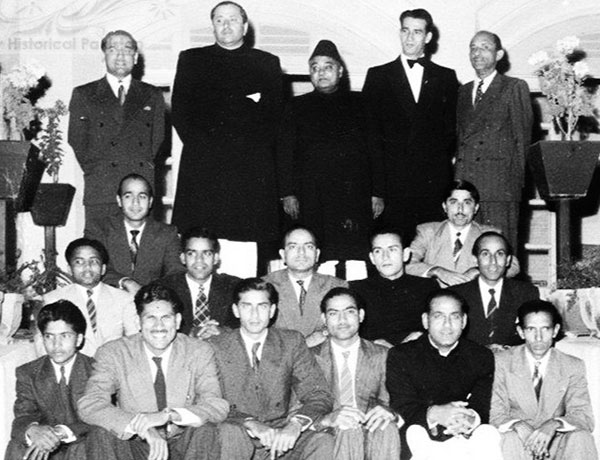
The ‘aristocratic’ Kardar (standing second from right) with Prime Minister Khwaja Nazimuddin and the Pakistan team.
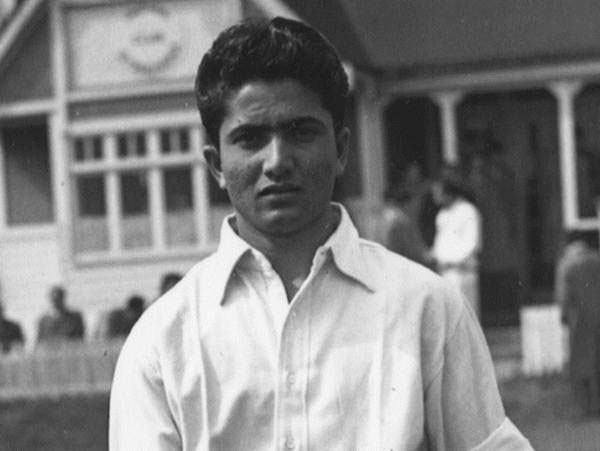
The classic Pakistani batsman, Hanif Mohammad. According to Hanif class conflict was rife in the Pakistan team in the 1950s and 1960s.
The Pakistani state’s patronage of industrialists reached a peak during the Ayub Khan regime (1958-69). When he took over power (in a military coup) in 1958, he at once set Pakistan on the course of state-backed capitalism in an attempt to quicken the country’s economic progress. A select group of families were given an open filed to set up factories and other businesses. Ayub did achieve the economic advancement that he was hoping for, but the fruits of this initiative failed to trickle down and benefit the majority of Pakistanis. Economic/class gaps between Pakistanis grew even more under Ayub. In 1962, the Pakistan cricket board decided to create ‘another Kardar.’
Kardar had retired in 1958 and was first replaced by swing bowler Fazal Mahmoud and then by wicket-keeper Imtiaz Ahmed as captain. Despite the fact that Hanif had risen to become the team’s leading and most experienced batsman, he was ignored. A young, 24-year-old Javed Burki was made captain for Pakistan’s 1962 tour of England. Burki was an Oxford graduate. He was the son of a senior military officer and came from an upper-middle-class family in Lahore. What’s more, since Ayub was a military man himself, the board chose an army officer as the team’s manager who could hardly tell the difference between cricket and football![10]
In their respective autobiographies, Hanif Muhammad and Fazal Mahmoud both praised Burki for his batting skills but lambasted him for being arrogant, snooty and insulting towards the players. As Pakistan began to lose one Test match after the other on the tour, Burki surrounded himself with a select group of players through whom he would communicate with the rest of the squad. Hanif wrote that Burki looked down upon the lesser educated and poorer players, whereas Mahmoud claimed that Burki would only talk to him through the manager.
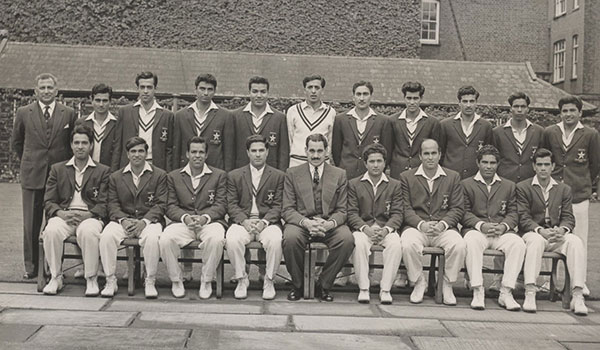
The Pakistan team during its disastrous tour of England in 1962. Class tensions within the team peaked during this tour.
Burki’s team lost the series 4-0 and he was finally replaced by Hanif. When in the late 1960s, the Ayub government began being cornered by a violent protest movement, socialist parties such as the Pakistan People’s Party (PPP), National Awami Party (NAP), and the Bangali nationalist outfit, the Awami League, began to emerge as the country’s three main civilian forces. The echoes of the commotion could also be heard in the country’s cricket team. When young opener Aftab Gul made his Test debut in 1969, he was already known as a radical student leader at the Punjab University.
Students used the playing venues during Pakistan’s matches against England in 1968 to protest. Crowds often invaded the grounds in Karachi and Lahore. They rioted and chanted slogans against Ayub. Debate and politics based on concepts such as class war and class conflict peaked in Pakistan during the anti-Ayub movement in the late 1960s. Then, politics in the country was turned on its head when (during the 1970 election) leftist parties wiped out old establishmentarian parties at the polls.
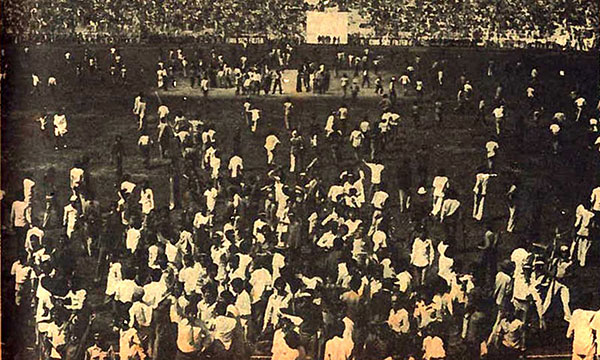
Protesting students invade the National Stadium in Karachi during a Test match against England in 1968.
However, from within this conflict and demand to turn Pakistan into a democratic socialist entity, also emerged groups asking for the democratic recognition of the country’s various ethnic communities and the autonomy of regions dominated by the Sindhis, Baloch, Pashtun and Bengalis. Even though the Bengali Muslims of India had enthusiastically accepted the creation of Pakistan, and East Bengal had become the eastern wing of Pakistan (East Pakistan), the Bengalis were the first to accuse the country’s Punjabis of monopolizing the military, the bureaucracy, sports and economics.
They also feared that the state of Pakistan was not introducing democracy because that would make the Bengalis the majority ruling group. The Bengalis also complained that despite the fact that East Pakistan was contributing heavily to the economy, it was the country’s poorest region. They accused the Punjabi ruling elite of being racist towards them and hell-bent on keeping talented Bengali sportsmen from the country’s hockey and cricket teams.
In 1971, a vicious civil war erupted in East Pakistan between Bengali nationalists and the military. As the civil war was raging, the Pakistan cricket team was touring England in June-July of 1971. After the second Test match in London, the English cricket board planned to auction a cricket bat signed by England and Pakistani players to raise money for those affected by a cyclone in East Pakistan. But a group of Pakistani players led by opener Aftab Gul refused to sign the bat.[11] Gul was a Maoist and unlike the pro-Soviet Marxists in Pakistan, the pro-China leftists in the country had been against Bengali nationalism.
Fearing that the event would be turned into an embarrassing episode by the British media, the Pakistan captain, Intikhab Alam and the team management requested Gul and his posse to sign the bat. But the men refused, saying that they were not willing to do anything that would benefit the ‘traitors’ (Bengalis). They only agreed to sign the bat when the government of Pakistan ordered them to. But class conflict in Pakistan cricket was already being replaced by a growing rivalry between players belonging from the country’s two major cricketing centers: Lahore (capital of Punjab) and Karachi (capital of Sindh).
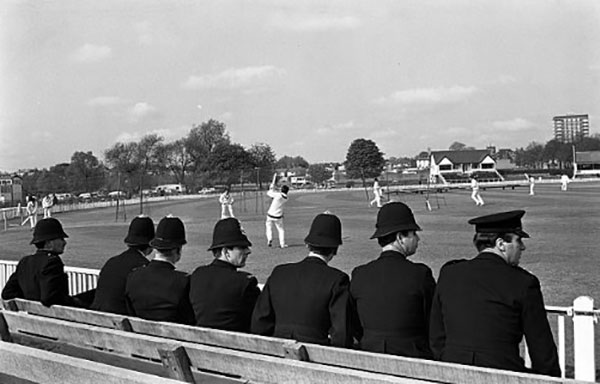
British police on the look-out for Bengali nationalists during a Pakistan practice session in London. The nationalists had threatened to attack the team.
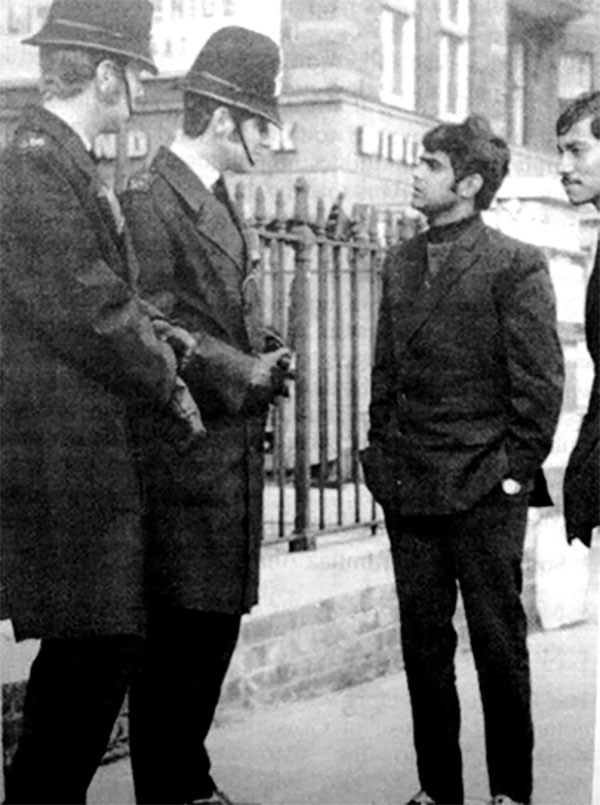
The little Maoist: Aftab Gul, London, 1971.
The ethnic spell
Lahore had a Punjabi majority and Sindh’s capital Karachi had a Mohajir majority (or Muslim Urdu-speakers who had migrated from Indian regions after the creation of Pakistan). The bulk of the players in the country’s cricket team had almost always been Punjabi or Mohajir. The quality of cricket in Karachi and Lahore was such that it became very tough for Bengali, Pashtun, Baloch or Sindhi players to enter the squad.
The Pashtun and Baloch did not say much in this respect because in those days cricket was not very popular in the areas dominated by the two ethnic groups. Already in 1969 when Saeed Ahmad (a Punjabi) was dropped as captain, Hanif Mohammad and his brother Mushtaq (from Karachi) were booed by the crowd at a Test match in Lahore. The Lahore press had alluded that Saeed’s dismissal had been ‘engineered by the Karachi lobby.’ Truth was, Ahmed, though a solid batsman, was a mediocre captain.
The populist Sindhi, Zulfikar Ali Bhutto, became Pakistan’s first elected head of state and government in 1971. He became PM in 1973. His party had won a sweeping majority in Punjab and Sindh (but not in Karachi). The Mohajirs, who had been part of the ruling elite in the 1950s, had begun to see themselves gradually ousted from the corridors of power by the Punjabis and then the Pashtuns. Their paranoia of being sidelined was further aggravated when Bhutto decided to make Sindhi Sindh’s official language. The Mohajirs protested and claimed that they were becoming the new Bengalis and that Pakistan’s politics was being stung by ‘provincialism.’
The Urdu print media in Karachi began to echo the Mohajirs’ concerns and this then spilled over into cricket as well. Even though the team had a number of players from Karachi, the media began to highlight the case of one, Aftab Baloch. Aftab came from a family in Karachi and was a prodigious batting all-rounder. He made his Test debut in 1969 at the age of 16 but was not played again until the Karachi press picked up his case. He continued to perform well in domestic cricket and the press claimed that the ‘Lahore lobby’ was keeping him out of the side.
The cricket board responded by selecting him for Pakistan’s 1974 tour of England but he wasn’t played in any of the three Tests. However, Aftab was finally given another Test against the visiting West Indian side in 1975. He scored a 50 in Lahore but was surprisingly dropped for the next Test in Karachi. The press again cried foul, but its campaign for Baloch gradually faded away along with the man.
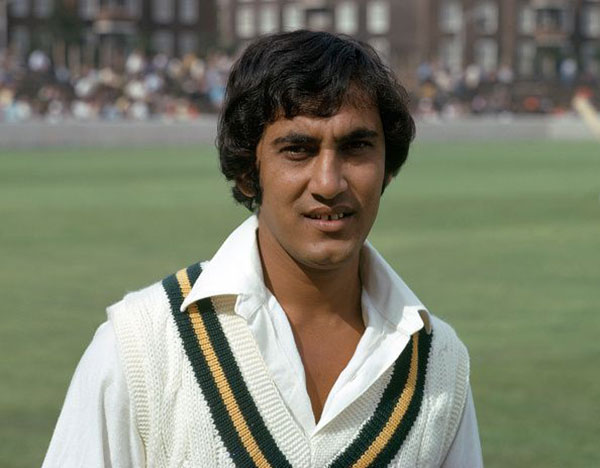
Aftab Baloch.
In 1976, Karachi’s Mushtaq Mohammad replaced Intikhab Alam as captain. But during his very first Test as captain (against New Zealand in Lahore) he had to fight tooth and nail with the selectors to keep his Karachi comrade, Asif Iqbal, in the side.[12] Like Mushtaq, Iqbal was a regular in the team, but had lost form during the West Indies series. Mushtaq also pushed for the inclusion of another Karachi player, the 18-year-old Javed Miandad.
The Lahore press accused Mushtaq of favoring Karachi players. But the accusation did not stick because both Iqbal and Miandad scored centuries and Pakistan won the Test. The ethnic issue hardly ever rose again in Pakistan cricket during Mushtaq’s captaincy (1976-79) and the team became a fine balance between talented Lahore players and the equally talented ones from Karachi.
But what were these Lahore and Karachi ‘lobbies?’ When the press mentioned them it largely meant the cricket associations in Karachi and Lahore who were empowered by the cricket board to run and develop cricket clubs and cricketers of the two main centers of cricket in the country and generate new talent for first-class sides and for Pakistan.
The associations also competed for funds and helped the national selection committee to spot emerging new talent. However, as politics based on ethnicity proliferated in the country from 1973 onwards, tussles, allegations and counter-allegations between Lahore and Karachi associations increased.
Members of both the associations regularly used the Urdu print media to propagate their point of view and accused each other of promoting Punjabi and/or non-Punjabi players. But it wasn’t only about the Mohajirs of Karachi and the Punjabis of Lahore.
During the 1976 series against New Zealand, the second Test was to be played in Hyderabad (in Sindh). The Sindhi press lamented that though Pakistan’s Prime Minister was a Sindhi (ZA Bhutto), there wasn’t a single Sindhi player in the cricket side. As a response, during a reception, the government gifted Sindhi caps and the Sindhi ajrak to members of the Pakistan and New Zealand squads.[13]
Some players even wore them and posed for the cameras. Miandad, a Guajarati-speaking Mohajir from Karachi, walked around in a Sindhi cap and told the press that since Karachi was in Sindh, he considered himself a Sindhi.
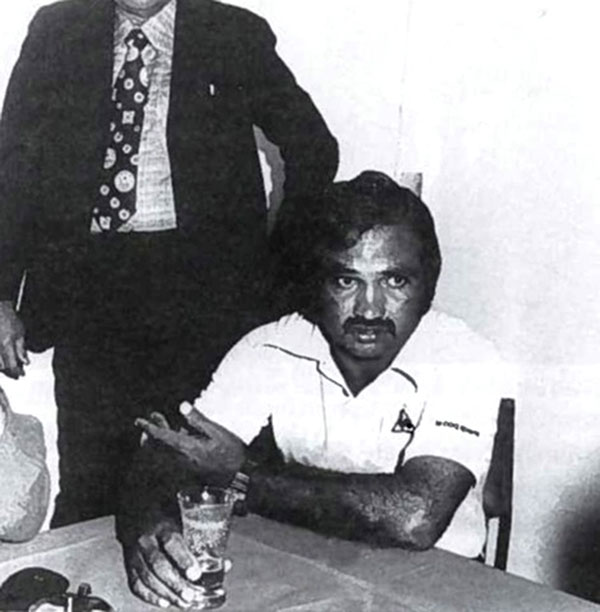
Karachiite Mushtaq Mohammad talking to the press during the 1976 Pakistan-New Zealand series. He clashed with the selectors to keep Karachi’s Asif Iqbal in the squad and launch the 18-year-old Karachi batsman Javed Miandad. Mushtaq needed a pint in hand to keep his cool.
In July 1977, a reactionary military coup toppled the Bhutto regime and imposed a harsh military dictatorship. But General Ziaul Haq’s dictatorship could not halt the politics of ethnicity. In fact, a sense of depravation (especially among Sindhis) grew manifold because Zia was a Punjabi and had toppled a Sindhi Prime Minister.
Karachi’s Mohajirs, who had opposed Bhutto, initially welcomed the coup but they were equally suspicious of the Punjabis. In 1978 when the Indian cricket team visited Pakistan, a young cricketer from Karachi, Amin Lakhani, was given a side game against the Indians. Incredibly, Lakhani, a left-arm leg-spin bowler, took a double hat-trick and was praised by veteran Indian spinner, Bishen Singh Bedi.
The Karachi press and the Karachi Cricket Association demanded that Lakhani be given a chance in the third Test of the series. He was named in the 14-man squad, but on the eve of the Test, he injured his hand and could not make the final 11. The press, however, claimed that Lakhani was fine and that the selectors had lied about the injury.
The Karachi press then went into overdrive when Lakhani wasn’t picked in the squad that was to tour New Zealand and Australia in 1979. The selectors dismissed the accusation of ‘Punjabi biasness’ by the Karachi press, saying that the team’s captain (Mushtaq) and vice-captain (Asif Iqbal) were both from Karachi. Lakhani never played for Pakistan.
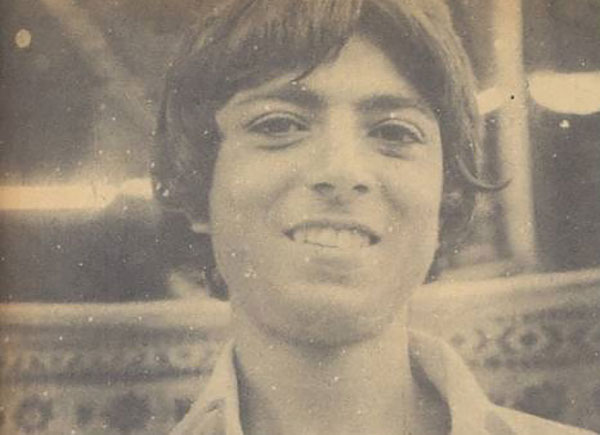
Amin Lakhani.
But this was nothing compared to perhaps the ugliest ethnic spat that took place in Pakistan cricket. In 1980 when Asif Iqbal (who had replaced Mushtaq as captain) resigned from the game (after losing to India in 1979), the cricket board’s new chairman, Nur Khan, recalled Mushtaq and asked him to become captain again. Mushtaq declined but suggested the name of 24-year-old Javed Miandad for the post. This must have bothered senior players such as Zaheer Abbas and Majid Khan. But since both had performed poorly against India, they were concentrating more on retaining their place in the side. Miandad won his first series as captain (against Australia) but lost the next two. The board and the selectors retained him as captain for the 1982 series against the visiting Sri Lankan team.
Shortly before the series, Miandad was quoted by the press as saying that the senior players in the team were not co-operating with him. Majid Khan took offense and invited nine players to his home in Lahore and told them that he was going to refuse playing under Miandad. He said that Zaheer had agreed to do the same. Soon, all the players at the meeting gave Majid the green signal to add their names and signatures to the letter of protest that Majid was planning to hand over to the board.
Apart from Majid and Zaheer, the rebel brigade included Mudassar Nazar, Imran Khan, Sikandar Bakht, Mohsin Khan, Sarfaraz Nawaz, Wasim Bari, Iqbal Qasim and Wasim Raja. The board decided to side with Miandad and he led a brand new team against the Lankans in the first Test of the series at Karachi’s National Stadium.
The ethnic angle to the whole episode first emerged when groups of youth in the stadium’s general stands began to raise slogans against the rebels (calling them ‘anti-Karachi’ and ‘Punjabi thugs’) and burned posters of Majid, Zaheer and Imran.[14]
The Karachi press accused Majid of playing into the hands of the ‘Lahore lobby’ who wanted to topple Miandad’s captaincy just because he was from Karachi and a non-Punjabi. Even the fact that the rebel lot included four players from Karachi (Mohsin, Qasim, Sikandar, Bari) -- and even Zaheer (a Punjabi settled in Karachi) -- could not deter the press from seeing the episode as a case of ‘Punjabi chauvinism.’
Pressured by the Karachi press and the state departmental teams that they played for in the country’s first-class tournaments, two of the Karachi players, Mohsin Khan and Iqbal Qasim broke rank from the rebels and rejoined the team. Wasim Raja, though a Laborite, also decided to rejoin.
By the third Test of the series, Zaheer, Imran, Mudassar, Sarfaraz and Bari also decided to rejoin the team, leaving only Majid and Karachi’s young pace bowler, Sikandar Bakht stranded. Now, it was the turn of the Lahore press to react. It accused the board and Miandad of coercing the rebelling players’ domestic teams to ban them. The players were employed on healthy salaries by the banks and airlines (PIA) that they played for in domestic tournaments. The Lahore press also accused Imran Khan of betraying his cousin Majid by accepting a lucrative new playing fee from the board. Nevertheless, Miandad resigned as captain after the third Test but on the condition that he was willing to play under any player, except Majid Khan. The board decided to appoint Imran Khan as the new skipper.
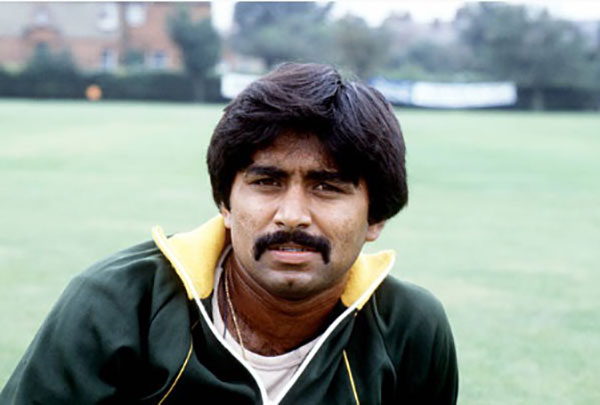
Javed Miandad faced his first players’ rebellion in 1982. The Karachi press described it as ‘an ethnic spat.’
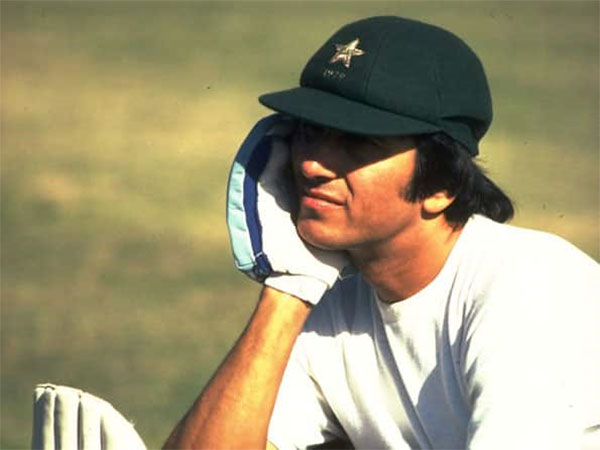
Majid Khan.
Since the politics of ethnicity (as a protest tool) became stronger during the Zia dictatorship in the 1980s, it kept affecting the country’s cricket as well. But each episode of it came with the kind of contradictions that one saw in the Miandad controversy. For example, throughout Imran Khan’s captaincy, the Karachi press accused Khan of undermining Karachi players like Iqbal Qasim and Qasim Omar, and forcing his Lahore contemporary, Abdul Qadir’s entry into the team.
Meanwhile, the Lahore press lambasted Khan for persisting with Karachi’s Mansoor Akhtar, despite the fact that the batsman was continuously failing to live up to his potential. The Karachi press claimed that Khan was also undermining Miandad’s seniority, and yet, when Miandad became Khan’s Vice Captain in 1986, he became one of the most influential decision-makers in the side after Khan.
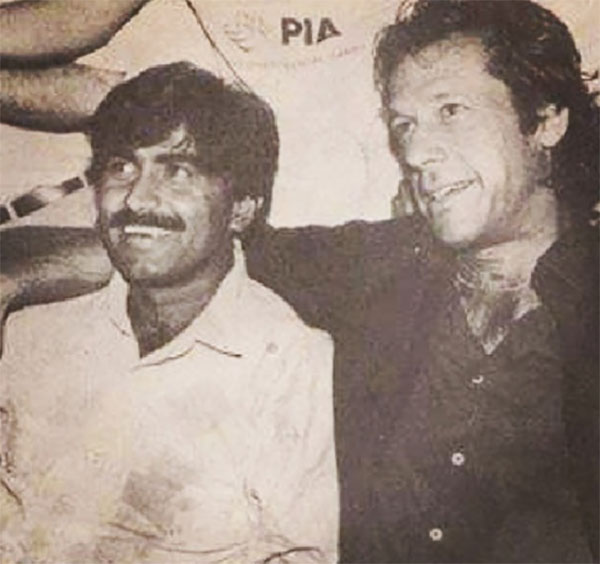
Miandad and Khan made the backbone of Pakistan cricket in the 1980s ...
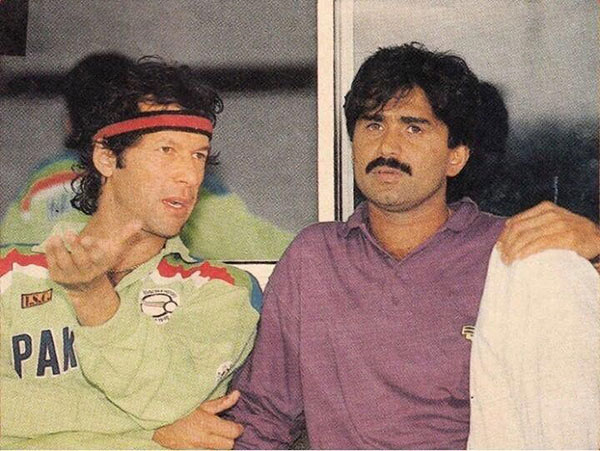
… But relations between them fluctuated. Miandad became the poster boy of the ‘Karachi lobby’ and Khan that of the ‘Lahore lobby.’
The faith bait
Politics of ethnicity began to recede after the demise of the Ziaul Haq dictatorship in 1988. Its last major impact on cricket came during another rebellion against Miandad’s captaincy in 1993. Miandad had replaced Khan in 1992 after the latter retired. But he faced a players’ rebellion in 1993 that was led by Lahore’s Wasim Akram and South Punjab’s Waqar Younis.
Miandad accused Imran of pulling the strings of the rebels[15] and the Karachi press lambasted Khan of the same. In his autobiography Miandad claimed that Khan was doing this to get back at him because he (Khan) believed that Miandad had tried to stir a mini-rebellion against Khan after Pakistan had won the 1992 Cricket World Cup.
Victories under Mushtaq and Khan’s captaincies had added to the popularity of cricket in Pakistan beyond Karachi and Lahore. For example, in the 1980s, for the first time players from the Pashtun areas in Khyber Pakhtunkhwa (former NWFP) and from small towns and villages of the Punjab began to make a mark. This, along with the changing nature of politics in post-Cold War Pakistan, also witnessed many changes in the country’s cricketing culture.
Till the arrival of Zia in July 1977, the nature and culture of Pakistan cricket teams was quite like that of the society. Faith hardly played a major role outside one’s home or mosque/shrine; and never in matters of business, arts and sports. However, it is also true that even during the height of the Zia dictatorship in the 1980s – when draconian laws were being introduced in the name of Islam, and extremist and sectarian organizations were emerging with the aid of the state – the impact of these laws would not be fully felt by the polity till after Zia’s demise in August 1988.
When Zia initiated his so-called ‘Islamization process’ through certain constitutional amendments, Ordinances and social engineering that (for the first time) saw the state providing space and patronage to a number of evangelical and Islamist organizations, this led to the proliferation of the radicalization and conservatism witnessed in the Pakistani society from the mid-1990s onward.
This trend also became apparent in the culture of the country’s cricket teams from the late 1990s. But even though, across the 1980s and 1990s, traditions such as celebrating victories with champagne and beer in the dressing rooms of the stadiums in Pakistan stopped after 1977, the practice largely continued whenever Pakistan won a game abroad. The practice of attending parties and nightclubs (when on tour) also continued and the faith of a player remained to be a strictly personal matter.
In Mushtaq’s team of the 1970s, a majority of players liked to drink. Mushtaq often carried a glass of beer with him during press conferences. But then there were those who didn’t drink, such as Majid Khan and Iqbal Qasim. Similarly, whereas Imran Khan, Wasim Raja and Sarfaraz Nawaz were notorious for being ‘womanizers’ and ‘party animals,’ there were also those who were extremely private about their personal lives.
Differing dispositions in this context hardly ever became a bone of contention between the players. For example, Miandad often performed the wazu (Muslim ambulation) before going in to bat[16] and Abdul Qadir regularly prayed five times a day. Yet, both also had a keen sense of having fun (of all kinds). Never were their spiritual practices exhibited by them in public.
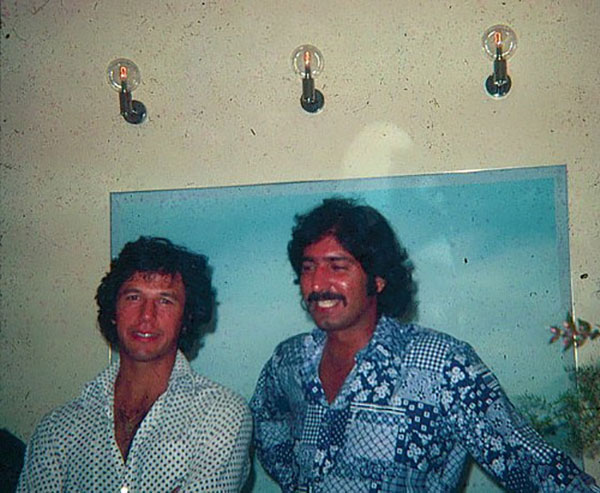
‘Party animals’: Imran and Sarfaraz at a nightclub in Melbourne in 1981.
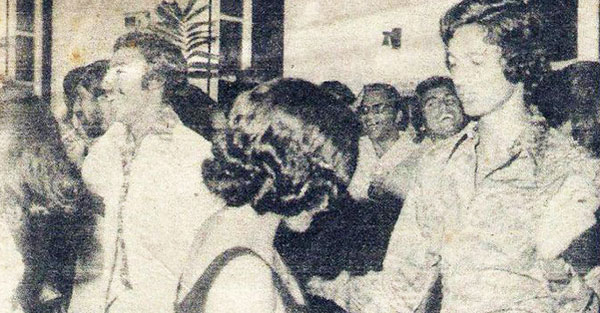
The Pakistan team ‘boogying’ at a party in 1977.
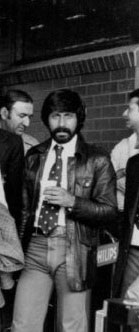
The flamboyant left-handed batsman, Wasim Raja, could hold his drink well.
But by the late 1980s, Zia’s ‘Islamization’ project, which, in a way, was using faith to actually institutionalize the act of exhibiting moral self-righteousness, had begun to kick in. Its first echo in the cricket team rang in the shape of Qasim Umar. Qasim Umar was a dashing young batsman from Karachi. He had cemented his place in the side in the early 1980s with a string of good scores.
Even though not particularly religious at the time, Umar struggled to fit into a squad whose members were outgoing, had raging hormones, and (as Umar would later claim) ‘drank too much.’ Umar was unable to bond with the players. But the straw that finally broke the camel’s back in this regard was when, during Pakistan’s tour of Australia in 1986, captain Imran Khan admonished Umar for playing rashly in a crucial ODI game.
According to Umar, Khan insulted him in front of other players in the dressing room even after Umar had scored a 50. After returning to Pakistan from the tour, Umar at once contacted a few journalists to tell them that he would not be playing under Khan’s captaincy. He told the press how Khan had insulted him. He then went on to say that his main issue with Khan’s team was a moralistic one. He claimed that the captain and his team were a bunch of ‘womanizers’ who often brought women into their hotel rooms. He accused the team of being habitual users of hashish/marijuana and that the players often took the drugs with them, hidden in batting gloves.[17]
It was Khan and his team’s good luck that they had been performing well and the press and the board dismissed Umar’s accusations as hogwash. In fact, it was the same team that Zia would use to smoothen Pakistan’s ties with India (‘cricket diplomacy’). Ironically, even though Zia’s regime was imposing one controversial law after the other in the country, he gave his approval to the board to hush Umar up despite the fact that Umar was behaving exactly the way Zia was (as a finger-wagging moralist).
Even if what Umar claimed was true, why did he need to critique Khan’s captaincy on moralistic grounds? The team was playing good cricket and its extracurricular activities did not include any serious misdemeanors, such as match-fixing. Interestingly, more than a decade later, Qasim confessed that he had thrown away his wicket for a bribe in 1984.
But it seems Umar was fooled into believing that if he used the Islamic card against Khan in Zia’s Pakistan, the press and the regime would be more sympathetic towards his grudge against Khan. It wasn’t and Umar was banned for life. He joined the conservative Islamic evangelical outfit the Tableeghi Jammat in the 1990s.
In the late 1980s, newspapers were rife with reports about how men and women had begun to use Zia’s draconian laws and policies to settle their scores with those that they resented. Islam became a weapon in the hands of the bitter and the exploitative. A number of Islamist outfits had already made in-roads in the politics of Pakistan by riding on the 1980’s Islamization process.
However, as most of them were militant, it were the evangelical movements that managed to reap the most success within the country’s changing social and cultural milieu. The evangelical groups also benefited from another trend that began to emerge within the urban middle-class youth of Pakistan: Never before did young Pakistanis exhibit so much interest in exhibiting religiosity as did the generations that grew up in much of the 1990s and almost all of the early 2000s. The evangelists started constructing feel-good narratives and apologias for the educated urbanites so that these urbanites could feel at home with religious ritualism, attire and rhetoric, while at the same time continue enjoying the fruits of amoral materialism and frequent interactions with cultures that were otherwise described as ‘anti-Islam.’
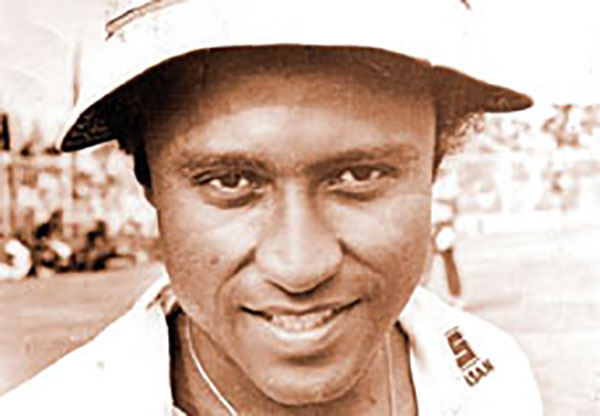
Qasim Umar.
The largest evangelical group in this respect was also the oldest. The ranks of the Tableeghi Jamat (TJ) -- a highly ritualistic evangelical movement -- swelled. But since the TJ was more a collection of working-class and petty-bourgeoisie cohorts and fellow travelers, in the 1990s it began to attract the growing ‘born again’ trend being witnessed in the county’s middle and upper-middle classes.
The Pakistan cricket team first started to mirror this trend in the late 1990s. The TJ approached the team in 1998 through former cricketer Saeed Ahmed who had joined the outfit in the mid-1990s. He managed to ‘gift’ the various players, audio recordings of lectures given by the outfit’s leading members.
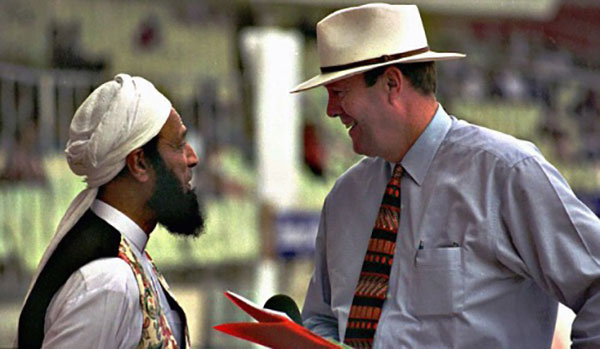
Former England captain and commentator, late Tony Grieg, interviewing Saeed Ahmad in Sharjah in late 1990s. Saeed, a former Pakistan captain had joined the TJ. He is said to be the man who introduced many Pakistani players to TJ.
Stylish left-handed opening batsman, Saeed Anwar, became TJ’s first recruit. He had lost his baby daughter (at birth) and had understandably fallen into deep depression. Like TJ members, he also grew a lengthy beard. According to a former Pakistani player who was in the managerial crew of the Pakistan squad that travelled to South Africa for the 2003 World Cup, Anwar became a completely changed man.
In 2015 he told me: ‘Saeed Anwar was a mild-mannered, gentle and quiet man. But on that tour (South Africa, 2003) he developed a habit of popping strange questions based on faith and morality. Once he barged into the dressing room and loudly asked the players, ‘is a woman who has committed adultery liable to be put to death?’ As usual, most players just kept quiet or inaudibly slipped out. But I finally confronted him and asked him what this question had to do with cricket? He was livid! That was the first time I had seen such rage in him. He accused me of being a bad Muslim and was literally foaming. However, our manager, Shahryar Khan, had a quiet word with him, and the next day he came to my hotel room and apologized.’
In his book, The Cricket Caldron, Shahryar Khan explains how on the same tour, Anwar told the players that angels would descend and help Pakistan win the Cup. After Pakistan was knocked out in the first round of the tournament, Khan jokingly asked Anwar whatever happened to the angels that he claimed would help the team win. Anwar replied: ‘They didn’t come because we (the team) are bad Muslims.’
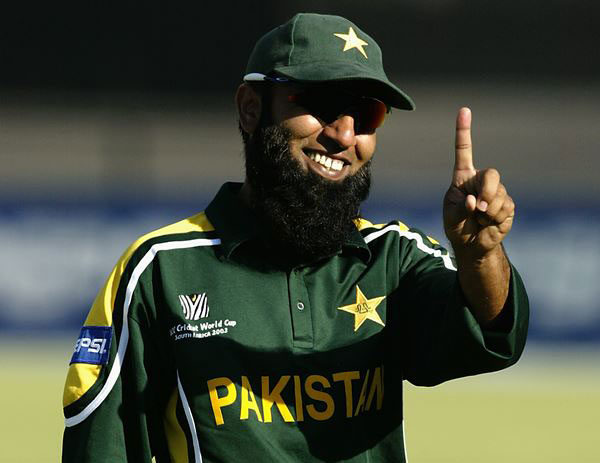
Saeed Anwar.
By 2003, the leg-spinner Mushtaq Ahmed and brilliant off-spinner Salqlain Mushtaq too had become TJ members. But it was the dashing batsman, Inzimam-ul-Haq, who became TJ’s biggest catch – especially when he was appointed captain in 2003. Much has been written about how under Inzimam more than half of the Pakistan team became ardent followers of the TJ and how he allegedly began favoring players who adhered to his beliefs and rituals.
Much has also been said about the tensions between Inzimam and tear-away fast bowler, Shoaib Akhtar, whose demeanor and disposition as a player and personality echoed the flamboyant antics of the Pakistani players of yore. The environment in the team was now experiencing the effects of the sectarian and sub-sectarian tensions that had become a disturbing norm in Pakistan in the early 2000s.
Sectarian and extremist violence had been on the rise ever since the 1990s. And so was violence between Pakistan’s Sunni Barelvi sect and the more puritanical Sunni Deobandi sect. It is the latter aspect of the sectarian conflict in Pakistan that seemed to have made its way into the team. The TJ members adhere to a highly ritualistic strain of the Deobandi school of thought.
Till the mid-1980s, a majority of players in the team came from urban backgrounds (Karachi and Lahore). But as mentioned earlier, after Pakistan began to win more Tests and ODIs than ever under Mushtaq Mohammad and then Imran Khan, cricket’s popularity grew beyond the major cities and reached small towns and villages of Khyber Pakhtunkhwa (KP) and Southern Punjab. Most players emerging from these areas were not as urbane or educated as the ones from Lahore or Karachi. Shahryar Khan wrote that from the late 1990s, the bulk of the Pakistan cricket team began being dominated by men from small towns. They formed a clique and were highly suspicious of players who came from bigger cities and (especially) were more educated.
Khan suggests that Inzimam was an extremely insecure captain. Apart from always suspecting Younis Khan of trying to dethrone him as captain, he was also unwilling to make those players who were more educated, part of his team. He thought that their ‘modern outlook’ and educated backgrounds would be detrimental to the team’s environment. Opening batsman Salman Butt was the most educated player in Inzimam’s side and the most urbane. But Inzimam never felt threatened by him because (at the time) Butt was too young, and, more so, had fallen completely in line with Inzimam’s ‘spiritual’ clique.
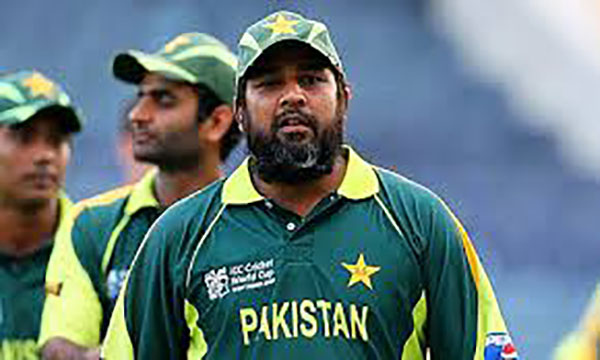
According to some observers Inzimam used faith to restore order in a team that was going through turmoil after it exited the 2003 World Cup and retirements. Others believe he did this to retain his captaincy.
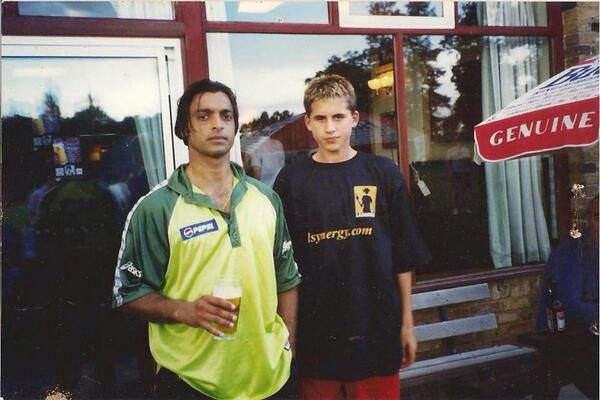
Tearawy fast bowler Shoaib Akhtar was a vocal critic of Inzimam’s tactics.
A new era
Misbah-ul-Haq made his Test debut in 2001 at the age of 26. But he lost form and was dropped in 2002. But in spite of performing consistently in domestic tournaments and being on the radar of the selectors, he was not selected. Many believe that it was Inzimam who made sure Misbah remained out. Why?
Misbah came from an urbane middle-class family in Mianwali (Punjab). He was an MBA and kept his religious beliefs to himself. But, apparently, that’s not the only reason why Misbah was kept out. A news report in a national Urdu daily in 2012 alluded that Misbah had refused to have anything to do with the TJ and that’s why Inzimam and company made sure he never got back in the side.
Misbah preferred to keep his faith a private matter and was not demonstrative at all about his beliefs, unlike the TJ members who consciously made it a point to flaunt and exhibit their faith. However, in 2007, when Inzimam retired, Misbah was at once recalled to the side and quickly graduated to become Pakistan’s most successful Test captain. However, in a 2014 interview that he gave me in Dubai (for Dawn newspaper) Misbah rubbished the idea that Inzimam had kept him out of the team. He said that at the time, the Pakistan batting line-up ran deep and it was very hard to fit another middle-order batsman. He chose not to comment on the sub-sectarian angle of the issue, and insisted that captains don’t pick sides on personal likes or dislikes.
Misbah is probably right. But if one is compelled to believe a man of his stature and modest disposition, then one cannot sideline claims made by a respected and elderly cricket administrator, Shahryar Khan as well. Khan only alluded to the sectarian angle, but was convinced that Inzimam went to great lengths to keep Misbah out.
When Misbah was made captain in 2011, the country was in the midst of an existential crisis. Extremist terror outfits were bombing mosques, markets and shrines, unabashedly downing civilians, cops and soldiers. The country stood on the brink of a war.
In 2011, Pakistan was staring into the abyss. Its rulers, military and polity were unsure how to contain the rampaging monsters of militancy, extremism and crime. The country was also facing growing international isolation. For example, no Test side was willing to tour Pakistan after the Sri Lankan team was attacked in Lahore by militants in 2009.
All of Misbah’s games as captain were played, won, lost and drawn on foreign soil. The irony of it all is that Misbah, who rose to become Pakistan’s most successful Test captain, was not even in the team when he was hastily made captain! When he was given the captaincy, he was making his third comeback to the side and that too at the age of 36, an age when most international cricketers either retire or start thinking about retirement.
Between the retirement of former Pakistan skipper, Inzimam (in 2007), and Misbah’s elevation to the post of captain 2011, the team went through five captains! The team could not play at home because that home kept plunging into extremist violence and political turmoil. During this testing period, the squad was also being torn apart by continuous infighting, players’ rebellions and charges of spot-fixing. It was mirroring the state of the nation at the time.
What’s more, when a bewildered Pakistan cricket board decided to hand over the captaincy to Misbah, he was still struggling to gain the kind of form required to play international cricket. He was asked to be a caretaker of sorts till the board could come up with a more permanent candidate for the captaincy. But this is when Misbah began to play his best cricket. After consolidating his place in the team again as a solid middle-order batsman, Misbah slowly began to peel off whatever that was left of the culture weaved by Inzimam’s captaincy stint (2003-2007).
Under Misbah, cricket alone became the thing with which to measure a player’s worth. He also tried to subdue the team’s reputation of being frustratingly unpredictable and impulsive by encouraging a more watchful, planned and cautious approach towards the game.
He was fervently criticized for this by some critics. But quietly he managed to pull the team together and out of its existential doldrums and inspired its slow march upwards in world rankings. Ever so slowly but surely, Misbah’s tactics began to bear fruit. However, on the way, he also managed to gather some exceedingly vocal critics who seemed enormously disturbed by his cautious attitude and the way he was dismantling the team’s culture designed by Inzimam and then by the short-term captains who had followed Inzimam in quick succession.
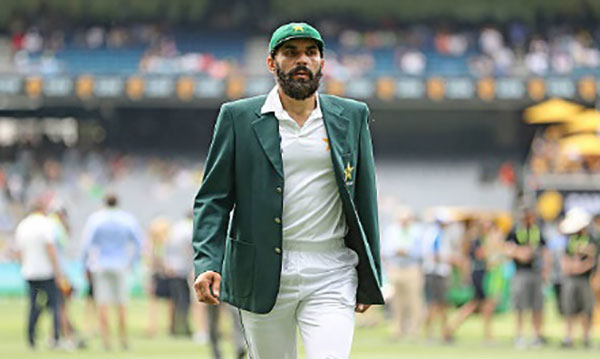
The healer: Misbah-ul-Haq
Teams under good and influential captains begin to reflect the personality of that person. Mushtaq Mohammad and Imran Khan’s teams reflected the flamboyant and intrepid ways of their captains, and same can be said about the team under Wasim Akram in the 1990s. Like Inzimam’s personality, the team culture under him became reticent and contrary: socially introverted, but exhibitionistic in matters of the faith, even though as a batsman he was in a class of his own.
The team under Misbah evolved a more stoic and determined dimension. Like Misbah, the team did not wear its faith on its sleeve. Faith once again became a private matter in Pakistan cricket. Misbah’s team was neither as colourful as the teams under Mushtaq and Imran; nor anything like what it had become during Inzimam’s captaincy.
It won’t be incorrect to suggest that with a stoic, quiet but stubborn determination, Misbah admiringly faced a number of unprecedented challenges. The kind of circumstances he as a captain was faced with -- such as cricketing controversies that he was never part of, and the violence and turmoil in his country that threw Pakistan cricket into exile -- he had to beat much bigger odds to become a great captain. So, in a way, while constantly playing away from home, Misbah’s team did not mirror what was happening in Pakistan. Interestingly, it can actually be said that perhaps for the first time, Pakistani politics began to mirror Pakistan cricket. For example, to stem the turmoil, controversies and in-fighting in the team, Misbah took a measured, pragmatic but determined approach. In 2015, the state and government of Pakistan began doing the same, especially after extremists massacred over 140 students at a school in Peshawar.
The military launched an unprecedented operation against extremist groups and then with the civilian government and political parties drew a National Action Plan (NAP) that was to be implemented to initiate political, religious and education reforms aimed at uprooting religious radicalization that had proliferated across various segments of the society in the last three decades. By 2017, terrorist attacks in the country had come down by 70 percent.[18] It was also in 2017 that Misbah bowed out, leaving behind a solid, stable side.
[1] Pakistan Was Created As A Lab: AA Jan (The News International, August 16, 2017).
[2] Imran Khan: An All-Round View (Chatto & Windus, 1988).
[3] R. Sen: Nation at Play (Columbia University Press, 2015) p.260.
[4] KR Wadhwaney: Indian Cricket Controversies (Diamond Books, 2017) p.18
[5] R. Sen: Nation at Play (Columbia University Press, 2015) p.260.
[6] Ibid.
[7] K. Asdar Ali: Surkh Salam: Communist Politics and Class Activism in Pakistan 1947-72 (Oxford University Press,2015.
[8] H. Mohammad; Afia Salam; Qamar Ahmad: Playing for Pakistan (Hamdard Press, 1999).
[9] Ibid.
[10] Ibid.
[11] Dr. N. Niaz: Fluctuating Fortunes (Pakistan Cricket Board, 2005).
[12] M. Mohammad: Inside Out (UniPrint, 2007)
[13] The Cricketer (November, 1976).
[14] The author (then 15 years old) was an eyewitness to this, watching the match from the general stand.
[15] S. Shafqat: Cutting Edge (Oxford University Press, 2004).
[16] Ibid.
[17] The Mirror (June 20, 2011).
[18] Centre for Research and Security Studies Report (January 1, 2019).
